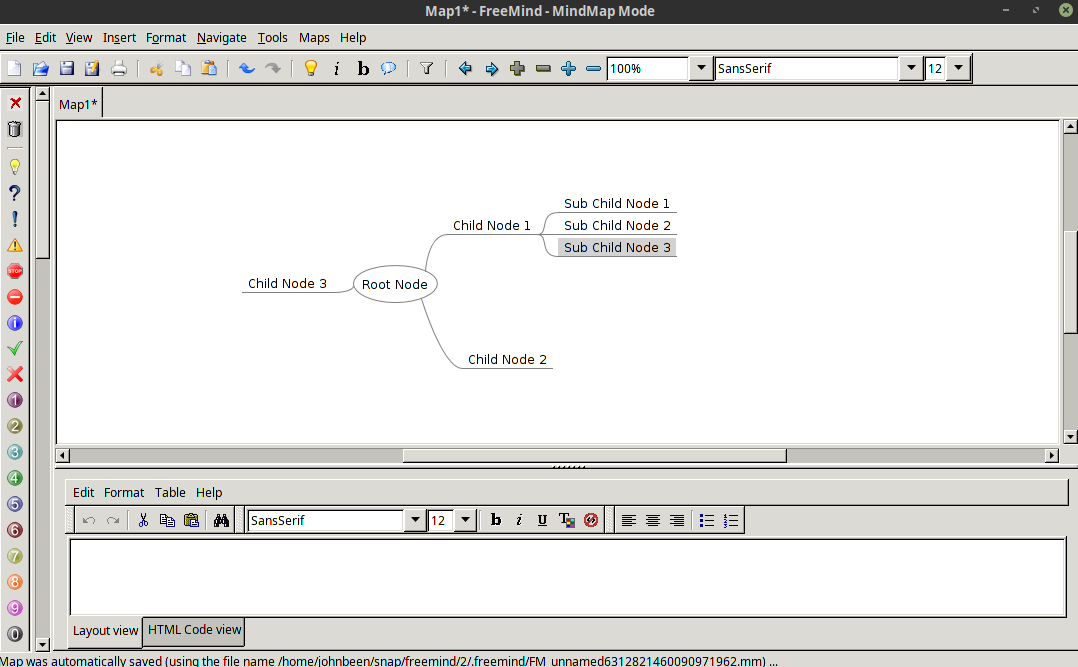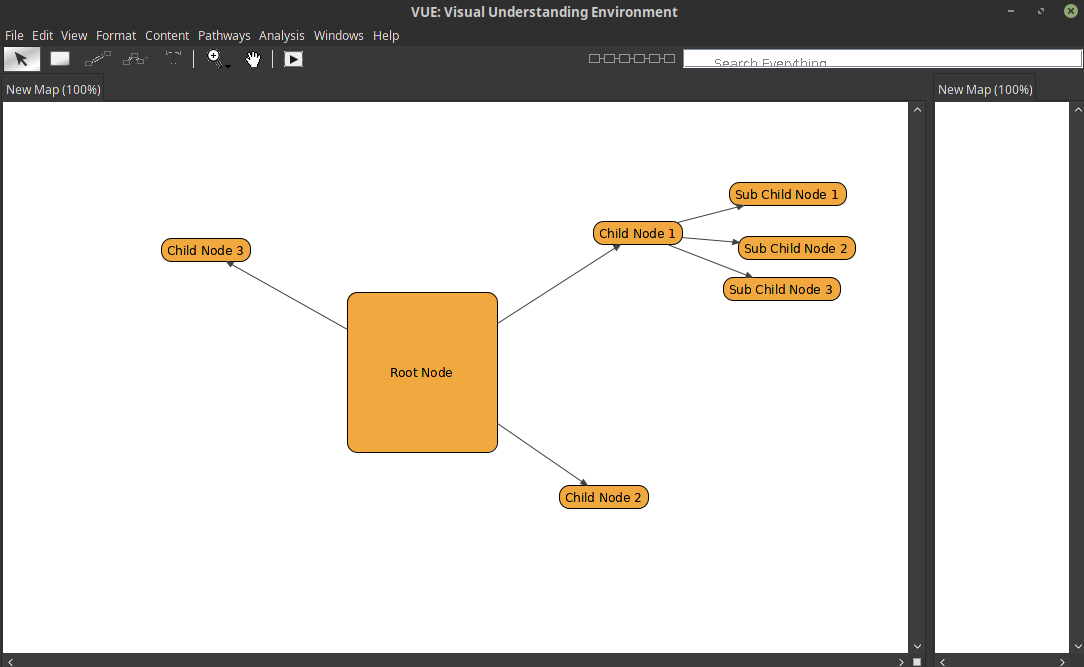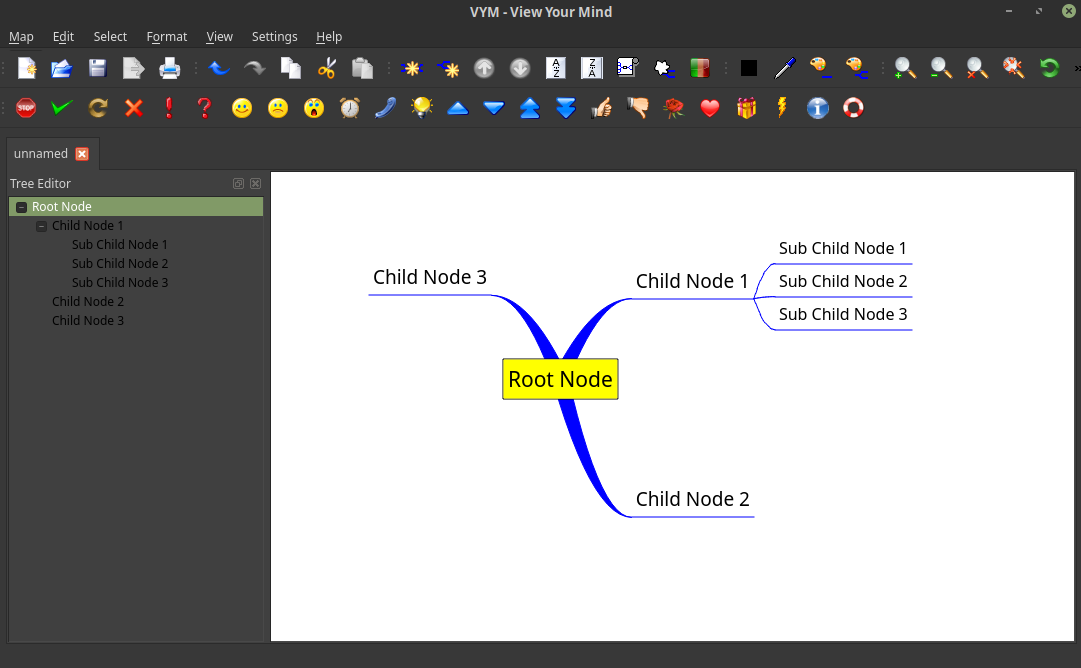As a child and in school we have been teached to do things in a linear way, which is based on old ways of remembering and learning via note taking and ordered lists, which can sometimes contradict with handling relatively unstructured chaotic problems that need to be solved. A mind map is a very natural way to write down thoughts organically without being hampered with our old school order and structure thinking. Mind mapping makes it possible to lay down your thoughts in a more visual way and develop your solutions by a transition from unstructured to structured in a organic workflow, by starting high level and adding more detail along the way. The whole process to mind map your thoughts matches the way your brain works in a better way. In this post I will discuss 4 good free mind mapping apps for Linux.
What is mind mapping
Mind mapping is the brainchild of Tony Buzan who popularized the idea of mental literacy and a thinking technique called mind mapping, earlier used by Leonardo da Vinci and others (source: tonybuzan.com). A mind map is a graphical paradigm for representing tasks, words, concepts, or items linked to and arranged around a central concept or subject using a non-linear graphical layout that allows the user to build an intuitive framework around a central concept. A mind map can turn a long list of monotonous information into a colorful, better memorizable and highly organized diagram that works more in line with your brain’s natural way of doing things (source: mindmapping.com).
The essence of mind maps
Mind mapping is based on some root essentials:
1) The main idea is always in the center of your mind map.
2) The main idea visually branches out into some main themes.
3) The branched out main themes have keywords to simply describe the individual branches.
4) The main branches will be further detailed via twigs with their own describing keywords.
5) Twigs can again further branched out to more detailed twigs.
Software solutions
In theory you only need a white paper and some colored pencils to make a mind map, but in these days of technological solutions, this is a perfect framework to convert into a software solution. Tony Buzan offers his own iMindMap software solution, which of course is closed source software, being used by Disney, BBC, Oxford University and Nasa. But our mind is on Free and Open Source software, so the question is, are there any good alternatives available for Linux. And the answer is Yes!
In this blogpost I will focus on 4 mind mapping alternatives for Linux:
- FreeMind
- VUE (Visual Understanding Environment)
- Freeplane
- VYM (View Your Mind)
FreeMind
Freemind is an open source, mind-mapping software program written in Java. Freemind is useful for organizing your ideas and for keeping track of all the things that are involved in completing a task. You can use Freemind to keep a personal knowledge base that is easy to manage. Freemind is an excellent application for mind mapping and brainstorming your ideas. What makes it so different from other mind-mapping applications? The main difference is its usability. The presence of a simple and intuitive interface makes the application easy to use and understand. It can be almost fully controlled by the keyboard. Freemind can be easily customized and has an extensive set of features. The entire process of creating, using, and sharing mind maps is made very user friendly.
(Source: http://freemind.sourceforge.net/wiki/index.php/Main_Page)
VUE (Visual Understanding Environment)
At its core, the Visual Understanding Environment (VUE) is a concept and content mapping application, developed to support teaching, learning and research and for anyone who needs to organize, contextualize, and access digital information. Using a simple set of tools and a basic visual grammar consisting of nodes and links, faculty and students can map relationships between concepts, ideas and digital content. VUE provides a concept mapping interface, which can be used as such, or as an interface to organize digital content in non-linear ways. VUE sets itself apart as a flexible tool to help faculty and students integrate, organize and contextualize electronic content in their work. Digital content can be accessed via the Web, or using the VUE’s “Resources” panel to tap into digital repositories, FTP servers and local file systems. VUE can be used by anyone interested in visually structuring digital content, whether in support of teaching difficult to understand concepts or more generally, a tool for organizing personal digital resources.
(Source: http://vue.tufts.edu/index.cfm)
Freeplane
Freeplane is a free and open source software application that supports thinking, sharing information and getting things done at work, in school and at home. The software can be used for mind mapping and analyzing the information contained in mind maps. Freeplane runs on any operating system that has a current version of Java installed. It can be run locally or portably from removable storage like a USB drive. Freeplane was created because of shortcomings in the design of the popular open source mind mapping program Freemind. Freeplane has been refactored from Freemind to make its code and packages more modular, make it easier for new software developers to contribute to Freeplane development, and to release new versions of Freeplane more often. Freeplane aims for maximum ease and speed of use. Occupying the middle ground between an editor and a diagramming tool, Freeplane allows the user to add content as quickly and naturally as they would in a text editor, yet producing structured content that can be manipulated as easily as a diagram. The workflow is unimpeded by the need to think about and manually place each piece of information; the user can intuitively input content as paragraphs and headings, and easily reorganise at a later stage.
(Source: https://www.freeplane.org/wiki/index.php/Home)
VYM (View Your Mind)
VYM is a simple but effective tool for storing and modifying information in an intuitive way. For example, you can reorder parts of the map by pressing a key, or easily add various information, like a complete email. Features include an easy to use graphical interface, with several windows like the map editor, note editor, history window and branch property window. It offers advanced editing features such as macros, bookmarks, associating images with a branch and modifier modes. And maybe a thing to mention is that the VYM website has been created within VYM itself.
(Source: http://www.insilmaril.de/vym/)
My first two cents on the tools
This will not be an in depth comparison, but a high level user analysis that is hopefully enough for you to decide on what to try out for yourself.
FreeMind
When starting FreeMind immediately a number of things stand out that are distinctive from the other alternatives. Because of the split of horizontally organized functional icons and vertically organized emoji like icons, it is immediately visually clear where to find what. When looking at the bottom of the screen you find a separate section with tabs for Layout view and HTML Code view. The latter shows html code adapting while you are creating your mind map, which is very usable functionality that separates FreeMind from the other offerings. The Layout view is always visible and there to use for your convenience to add notes to a node in a fast way. Just hovering over a node with a note embedded shows the content of the note without the need to click on it.
What frustrates me a bit is why I just can’t single or double click on the root node and change its name, while it is possible for child nodes. So I need a right click and select edit node before I can change the root nodes name. Why a different approach for root node and child nodes?
Via File/New Map you can create a new map When you create more than one map these maps are presented in different tabs instead of in different application windows. I like this approach and luckily this is a way of presentation available in the other alternatives as well. Via File / Create an encrypted map you can…well…create an encrypted map.
Just click anywhere on the map and your cursor changes into a cross icon, meaning that you can move around your canvas to your liking. Right clicking on the root node gives you a pop up with a lot of options. Via the same pop up you can add hyperlinks, add images, apply styles, but no password protection as offered in Freeplane. But password protection on node level can be done via the insert menu item. Just select a node and hit the insert button to add a new child note, which works very fast. Each child node has a kind of a handle which helps to move around the node to your liking. Select whatever node and via tools you can change the node into the root node. When a node has multiple child nodes, just click on the point where the branches connect and you can fold and unfold the lower level nodes.
There are a couple of things that are implemented while not feeling actually finished. When a child note has been created on the left side of the parent node and you move it to the right of the parent, the connecting branch line stays attached to the right of the child node. In the alternative apps the branch line is than nicely moving to the left of the node automatically. When two child nodes have been created for example both on the right of the parent node and I move up the lowest one of the two than both are moving upwards. That could be convenient, but what if I want to move the one above the other. Maybe I am missing something here but I can’t find to move the lowest one above the other. But why is this possible for a child node that was created on the other side of the parent node? And when I have created multiple maps which are presented via tabs I can’t close some of those tabs. Small things but a bit annoying.
When finished there are a lot of export options, like html, java applet, svg and flash. There are some nice import features as well, like importing a folder structure on your hard drive and convert it into a mind map like presentation.
This description gives only a small part of what is actually possible with FreeMind. It offers a lot of functionality, it has a well laid out user interface and some nice unique things as well, but some quirks in the design does hamper real user friendliness.
VUE
The Visual Understanding Environment (VUE) is an Open Source project based at Tufts University. The VUE project is focused on creating flexible tools for managing and integrating digital resources in support of teaching, learning and research. VUE is much more than only a mind mapping tool. It offers a very extensive set of tools to create a diversity of different visual overviews. When you look at the website of VUE some examples are there in the gallery section which show for example the Boston public transport map to showcase VUE’s packaging capabilities and, a people relationship map to show off VUE’s image support. VUE can be used to create presentations by using playback pathways in a linear fashion to show images slide after slide but you can use non linear navigation tabs as well. VUE 2.0 also has the capability to generate connectivity matrices, which in turn can be imported into existing statistical packages for further analysis. The search tool allows to query nodes and links in large maps. Search results can be highlighted, hidden or filtered.
When you open up VUE you are being presented with an empty map. Compared to the other alternatives discussed in this blogpost, the user interface is really simple. Only a couple of buttons are available in the menu bar, like the node tool, relationships, a text tool and zoom options. Very minimalistic, which isn’t automatically a bad thing.
When you hit the node tool, your cursor change in a crosshair and you can start adding nodes in your map. You can create node after node while they are not connected yet, which sounds very flexible and fast at first, but isn’t really following the idea behind mind mapping as described by Tony Buzan. The initial idea is that you start from the root node and make branches with sub nodes and from there create sub sub branches and so on. This is a very organic process which is kind of missing in VUE as you create nodes first and then think about how to connect them. This can work ofcourse, but is in my opinion missing the whole theory of organic mind mapping.
But it doesn’t mean real mind mapping functionality isn’t there. The menu bar also has a rapid prototype button. When you create your first node and select the rapid prototype option you can now drag child nodes directly from the parent node, which is a powerful solution.
When you create a bunch of nodes you can use edge handles to resize nodes. When you click on a node, hold alt and move your mouse pointer to another node a connector will be created. This is a nice and fast way of working, but my problem with it is that working this way doesn’t automatically implement parent child relations, which is one of the key concepts of mind mapping.
VUE offers a lot of formatting options and they work really great. Shapes, line types, fill colors, line weight, arrow formats, you name it, everything is there. Very good implemented. Really powerful as well is the possibility to change the way lines are curved. Very flexible and powerful functionality. As already mentioned the rapid prototype functionality is a powerful way of creating child nodes in a fast way. Much better implemented than the alternatives in this post.
Freeplane
When starting the application Freeplane the first thing I notice is that it has a clean interface, but the icons are too close to each other for my taste. I like a more spacious UI and the menu area looks a bit cramped. Maybe part of the reason for that is that all icons are boxed. Probably a non-boxed design would give more air to the UI.
Via File/New Map you can create a new map based on some standards templates. When you create more than one map these maps are presented in different tabs instead of in different application windows. I like this approach. The new created map presents you directly your standard root node, the starting point for your mind map, as it should be according to the earlier described theory.
Just click anywhere on the map and your cursor changes into a hand icon, meaning that you can move around your canvas to your liking. Right clicking on the root node gives you a pop up with a lot of options, like multiple options to edit in a dedicated dialog, which works like a mini text editor. Nicely implemented. Via the same pop up you can add hyperlinks, images, apply styles and even password protection. What I miss here is an insert option for a new child node, but just hitting the Insert button on your keyboard works faster anyway. Each child node has a kind of a handle which helps to move around the node to your liking.
When you create multiple branches from a child node, you can choose to fold and unfold branches from this node for one level or all underlying levels. This works very effective and fast. You can disconnect a node from the current parent and connect it to another parent by simply selecting it and dragging it to another parent. You can do this for a whole group as well.
Freeplane offers the possibility to create an html file from your mind map. When you integrate this html file in your web design, you suddenly have a interactive mind map as one of your webpages. You can also publish a mind map directly on the Internet or Intranet. In that case Freeplane is needed to view the map.
This description gives only a small part of what is actually possible with Freeplane. It offers a lot of functionality, including robust filter options, but doesn’t hamper user friendliness. Though the UI could have some remodelling, maybe towards a more modern flat and airy design.
VYM
Directly after starting VYM the user interface is a bit more playful and more fun when compared to for example Freeplane. Where Freeplane wants to be more professional, VYM wants to be joyful to use for a broader user group. Icons are very colorful and for example the connectors do follow the rules set by Tony Buzan abit more. It must be colorful and organic and higher level branches must be more prominent than lower level twigs and branches need to be a bit swirly and VYM has listened to that for sure.
Via Map/New Map you can create a new map based on some standards templates. When you create more than one map these maps are presented in different tabs instead of in different application windows. I like this approach, just as I like this concept in Freeplane. The new created map presents you directly your standard root node, the starting point for your mind map, as it should be according to the earlier described theory.
Very nice is the implementation of the Tree editor. So it is possible to edit directly in your mind map or you can choose to edit via the tree editor, whatever is more convenient for the user.
Just click anywhere on the map and your cursor changes into a hand icon, meaning that you can move around your canvas to your liking. Left clicking and hold on whatever object in the mind map makes it possible to move them around. Right clicking on the root node gives you a pop up with some important options like adding branches as child. One of them is the selection of the Property window, which gives some useful edit options in a separate section of the screen, where we can change the geometry, the colors, etc.
When a node has been created there are some nice emoticon like icons for good, bad, important, not important, idea, dangerous, etc. that can be attached to a node to make it visually more readable. When you create multiple branches from a child node, you can choose to fold and unfold branches from this nod, but I liked the implementation of this in Freeplane much better. Visually indicated by a plus sign directly on the node is much more clear than going to the menu bar to fold or unfold a node. But what is nice is that you can sort the branches linked to a node in alphabetical order. Further it is very easy to move branches to another node by just picking it up and moving there.
If you need to add more information than the basics just press the “n” key and a note editor pops up. Now you can add detailed notes to a specific branch. When you want to add a bookmark from your browser, just select the text in the address bar in your browser and move it to your mind map. Very easy to do. Further you can customize the complete UI of the application. Just move toolbars to another location and voila.
This description gives only a small part of what is actually possible with VYM. It offers a lot of functionality, but you can choose to show or not show everything that’s possible. In my opinion from a design point of view it is close to the initial essence of mind mapping as Tony Buzan had it in its mind: simple, organic, colorful and joyful to stimulate the brain as it supposed to do.
Conclusions
Based on everything that I can find on mind mapping tools for Linux I think we can conclude that FreeMind is in theory probably the most used and most popular mind mapping tool in the Linux world. But in my opinion that isn’t totally deserved due to some quirks in the design that hampers real user friendliness. VUE is probably the offering with the most comprehensive package of functionalities and has a very powerful way of creating child nodes from the parent node, but the question is if the amount of functionalities is a measure for quality or keeping you from focussing. An overload of functionality has impact on for example the learning curve and the possibility to actually focus on the job to be done. Sometimes simplicity and scoping and the focus on just one type of functionality makes an application better in its own right. FreePlane is a fork of FreeMind with the idea to do some things better, but in my opinion that is not really visible for the user. The UI is much more old fashioned than FreeMind and is missing the nice layout and presentation of different scopes of functionality. But Freeplane offers further the same powerful functionalities as FreeMind. VYM or View Your Mind has in my opinion the most friendly interface and feels a bit more modern compared to the other offerings and it offers a very nice implementation of the Tree editor. In my opinion from a design point of view VYM is the closest to the initial essence of mind mapping as Tony Buzan had it in its mind.
When I compare the discussed mind mapping solutions I think VUE is the best overall software solution from a functional perspective, because it offers the most broad package of useful functions. I feel that VYM is the most user friendly laid out tool, with a very clear and fresh interface and the simplicity helps you to just focus on the mind map job top be done. If VYM implements the way how VUE simplifies the way child nodes can be created, than VYM was the perfect tool for me. FreeMind and Freeplane are great as well but are a bit more rigid and due to more functions and options have a bit steeper learning curve.
No software solution is overall the best but depends on the use case, the type of user and the required possibilities. When you like simplicity, choose VYM. When you need all bells and whistles and a very fast way of making maps, choose VUE. When you need something in between, FreeMind and Freeplane are good solutions as well.








